Mount Everest Expedition | Highest Mountain Climb Information
Mt. Everest is the highest and the most magnificent mountain in the world. Towering 8,848m/29,029ft above sea level, Everest is located in the Mahalangur range between Nepal and Tibet. The south side of Mt. Everest lies in Nepal while the north side lies in Tibet.
Everest attracts considerable attention and climbing attempts. Everest is still the ultimate mountaineering adventure. The first climbers to officially reach the summit of Mt. Everest in 1953 were Tenzing Norgay, a Nepali sherpa mountaineer, and Sir Edmund Hillary, a New Zealand explorer. Tenzing Norgay had already been up to higher than 8,000m the previous year, but it was Hillary’s first attempt at the mountain.
Time duration of Mount Everest Expedition
Generally, Mount Everest Expedition takes around 50-60 days to complete depending on preparation, training, weather, and many more. The Mount Everest expedition is not as easy as trekking the Everest base camp. Getting to the top of the highest mountain in the world is way more challenging and tougher than you think.
The weather, temperature, including climbing requirements at Everest, is demanding. You ought to have a long acclimatization schedule before you could reach the summit successfully and get back down. Besides that, the process of climbing up and acclimatizing to such an altitude-making way goes on for a long time. Also, the journey up to the summit is the deadliest.
The altitude above 8000m while climbing Everest is the Death Zone. The risk factor is very high while summiting Everest. So, managing all the things for a successful summit takes time.
Mount Everest Expedition History

The first climbers to officially reach the summit of Mt. Everest in 1953 were Tenzing Norgay, a Nepali sherpa mountaineer, and Sir Edmund Hillary, a New Zealand explorer. Tenzing Norgay had already been up to higher than 8,000m the previous year, but it was Hillary’s first attempt at the mountain.
Clinton Thomas Dent, president of the Alpine Club, suggested that climbing Mt. Everest was possible in his book Above the Snow Line in 1885. The first climbers to officially attempt to climb Mt. Everest began in 1921. The northern approach to the mountain was discovered by Gorge Mallory and Guy Bullock. They climbed the North Col to an altitude of 7,005m/22,982ft and became the first Europeans to set foot on Everest’s flanks.
1922 was the first time a human was reported to climb higher than 8000m. George Finch reached an elevation of 8,320m/27300ft, using oxygen for the first time. The next expedition, in 1924, was aborted by Mallory and Geoffrey Bruce. After that, Norton and Somervell traversed the North Face and managed to reach 8,850m/28,050ft without oxygen and in perfect weather. On 8 June 1924, George Mallory and Andrew Irvine attempted the summit via the North Col-North Ridge-Northeast Ridge route.
They never returned. Mallory’s body was found on the North Faces in a snow basin below and west of the traditional site of Camp 4, by the Mallory and Irvine Research Expedition on 1 May 1999. Since then, the controversy has raged in the mountaineering community as to whether one or both of them reached the summit 29 years before the confirmed ascent and safe descent of Everest in 1953 by Norgay and Hillary.
In a ninth British expedition led by John Hunt, two climbing pairs were selected for a summit attempt. On 26 May 1953, the first pair, Tom Bourdillon and Charles Evans came within 100m of the summit. But they turned back after running out of oxygen. Then, two days later the second climbing pair of the expedition made its second assault on the summit. The second pair made the first-ever successful climb to summit Mt. Everest; Tenzing Norgay and Sir Edmund Hillary. On 29 May 1953, via the South Col route, they reached the summit at 11:10 am local time.
After the first successful summit of Everest, other ambitious record-setters have sought to make their mark in its history book. The first confirmed summit from Mt. Everest’s North Side was by Tibetan Nawang Gombu and Chinese mountaineers Wang Fu-Zhou and Chu Yin-Hau on 25 May 1960. Japan’s Junko Tabei became the first woman to climb Everest in 1975. In 1978, Reinhold Messner and Peter Habeler became the first to reach the summit without supplemental oxygen.
Reinhold Messner also became the first solo climber to reach the summit in 1980. The first blind person to reach the summit was Erik Weihenmayer in 2001. There is also a record of the oldest person to reach the summit – Min Bahadur Sherchan, aged 76. At the age of just 13, Jordan Romero recorded his name as the youngest person to reach the summit. And in 2005, Mona Mulepati and Pem Dorja Sherpa, a Nepalese couple, were recorded as the first couple to get married atop Mount Everest.
Highlights of the Mt. Everest expedition
The ultimate mountaineering adventure
First-ever successful Everest climbers, Tenzing Norgay, and Sir Edmund Hillary summited on 29 May 1953
The first confirmed summit from Mt. Everest’s north side was the expedition party of Tibetan Nawang Gombu, and Chinese mountaineers Wang Fu-Zhou and Chu Yin-Hau on 25 May 1960
First to reach the summit without supplemental oxygen were Reinhold Messner and Peter Habeler, in 1978
The first, blind person to reach the summit was Erik Weihenmayer in 2001
The youngest person to reach the summit was Jordan Romero (13 years old)
The first man to ski down Everest in the 1970s was Yuichiro Miura
Mount Everest Expedition Routes
Located on the border of two countries, Mt. Everest is part of the magnificent Himalayas range. With this location, there are two main climbing routes available. One is from the southeast ridge of Nepal, and the other is from the north ridge of Tibet. The southeast ridge expedition from Nepal is the most popular and most scenic. Mt. Everest was first conquered from that ridge by the two legends Tenzing Norgay and Sir Edmund Hillary.
After their successful summit on 29th May 1953, the southeast ridge expedition gained popularity. To date, hundreds of climbers around the world have successfully conquered the summit of Mt. Everest. The main climbing routes on the south and north sides of Everest vary greatly. Expedition through the south ridge to the summit is more direct and steep than that of the north side.
It makes summiting somewhat more challenging, yet a climber in distress can descend to safety much quicker on the south side. Additionally, helicopter evacuations are possible from Base Camp and Camp 1 above the Khumbu Icefall, which is not located on the north side. The southeast ridge route expedition begins from the Base Camp on the south side of Everest at 5,380m/17,700 ft in Nepal. The expedition journey begins by flying from Kathmandu into Lukla. After trekking for around one week to Base Camp, true climbing begins.
Everest Base Camp is at an elevation of 5,380m/17,700ft. Trekking to the Base Camp allows proper altitude acclimatization to prevent altitude sickness. The climbing equipment and supplies are carried by yaks, dzopkyos, and human porters to Base Camp. You will experience proper acclimatization and preparation before ascending to Base Camp 1 of Everest. During your stay at Base Camp, you will take a short hike and practice climbing with Sherpa guides using climbing gear. And after checking everyone’s health condition in the expedition party, the journey will continue. Camp 1 at 6,065m/19,900ft Behind the Base Camp, you cross crevasses, seracs, and ice black. The route progresses up to chunks of ice, as large as houses, on the route. You will use ropes and cross aluminum ladders to climb up to Base Camp 1.
These are the most dangerous sections of the route. While climbers prepare for the expedition, some Sherpas and expedition climbers will set up ropes and ladders in the treacherous Khumbu Icefall during acclimation. Base Camp 1 is located in a flat area. Camp 2 or Advanced Base Camp (ABC) at 6,500m/21,300ft After Camp 1, climbers continue their way up the “Western Cwm” to the base of the Lhotse face. The Western Cwm is a flat, lightly-rising glacial valley, marked by immense lateral crevasses in the centre. It prevents direct access to the upper reaches of the Cwm. It is followed by a small passageway, known as the “Nuptse corner”. The Western Cwm is also described as the “Valley of Silence”. The topography of the area frequently cuts off wind from the climbing route.
The high elevation and a clear, windless day can make the temperature at Western Cwm feel extremely warm for climbers. Camp 3 at 7,470m/24,500ft From Camp 2, climbers climb the Lhotse face on fixed ropes with one-way traffic for ascending and descending. Lhotse is the 4th tallest peak in the world. Finding a foothold is challenging even with crampons in this wall of rock of hard, blue ice and packed snow. Camp 3 is located on a small ledge at 7,470m/24,500ft. Camp 4 at 7,920m/26,000ft Camp 4 is another 500m away from Camp 3.
The Camp 3 to Camp 4 journey brings two additional challenges for climbers. The first one is the Geneva Spur, and the second is the Yellow Band. The Geneva Spur, also called Saddle Rib, is a large rock buttress near the summits of Mts. Everest and Lhotse. Similarly, the Yellow Band is a section of interlayered marble, phyllite, and semi-schist, which also requires about 100m of rope for crossing.
Fixed ropes help climbers scramble over this snow-covered rock band. Most climbers begin using oxygen at this point. After Camp 4, you will be at the top of the highest mountain in the world. One step further and your dream will come true. Summit of Mt. Everest - 8,848m/29,029ft Ascend another thousand meters and you will be atop the summit. With hopes of reaching the summit within 10 to 12 hours, climbers begin their summit push around midnight. This is the day climbers enter the “death zone”, the elevation over 8,000m where the oxygen pressure is insufficient for human life for an extended time. After that, climbers reach “the balcony” at an elevation of 8,400m/27,600ft.
It is a small platform where climbers can rest and gaze at peaks to the south and east in the early light of dawn. After the balcony, you will take a series of imposing rock steps, which usually force climbers to the east into the waist-deep snow. It is a serious avalanche hazard. Then, a small table-sized dome of ice and snow signifies the South Summit at 8,750m/28,700ft. The South Summit is a subsidiary peak to the primary peak of Mt. Everest. On the South Summit, climbers follow the knife-edge southeast ridge onward, known as Cornice Traverse. Snow clings to intermittent rock here. Besides that, it is the most exposed section of the climb. A misstep to the left from here would cause a fall of 2,400m/7,900ft under the southwest face, while to the immediate right is the 3,050m/10,010ft Kangshung Face.
The exposure on the ridge is extreme, notably while traversing large cornices of snow. Likewise, at the end of this traverse (at 8,790m/28,840ft) is a grand 12m/39ft rock wall; the Hillary Step, as the climbers first ascend these steps, were Hillary and Tenzing. Using fixed ropes previously set up by Sherpas, climbers ascend this step. Beyond the Hillary Step, climbers must traverse a loose and rocky section that has a large entanglement of fixed ropes that can be troublesome in bad weather. But, it is a relatively easy climb to the top on moderately angled snow slopes onward. Finally, you are at the top of the highest mountain in the world, Mt. Everest.
You will be surrounded by the greatest mountains in the world. The feeling of a successful summit of Mt. Everest is beyond imagination. The summit is capped by snow above ice over rock, and the layer of snow modifies from year to year. The top of Mt. Everest has been described as the “size of a dining room table” by successful climbers.
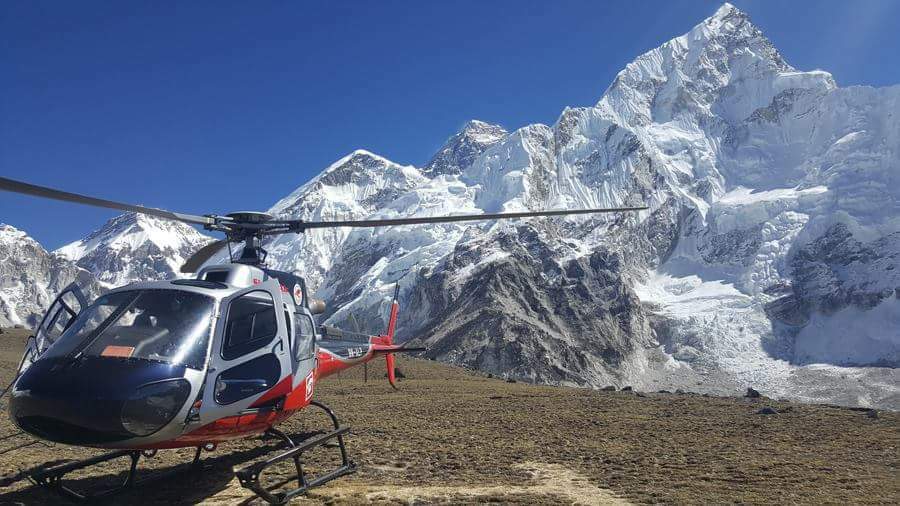 popular
popular
Everest Base Camp Helicopter Tour
$ 1300.0 $ 990.0
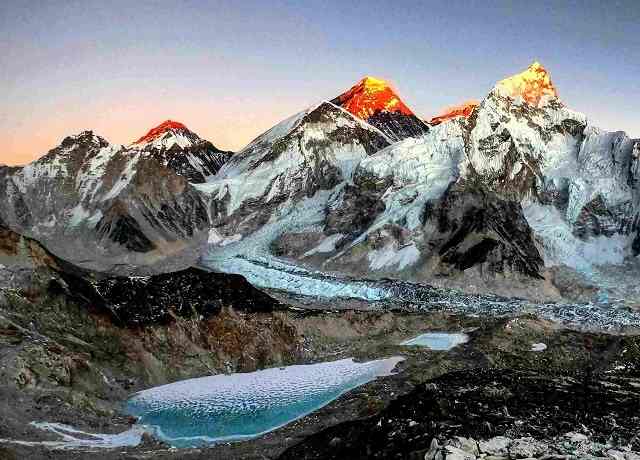 popular
popular
Everest Base Camp Trek 14 days | EBC Trekking
$ 1350.0 $ 1100.0
Everest Expedition Challenges and Technique
Most climbers become sick for several reasons that include extremely cold temperatures and high altitude.
Most climbers/trekkers develop an upset stomach on their way to Base Camp. Food in Nepal isn’t unhygienic, however, adapting to food is a real challenge for trekkers/climbers.
It is recommended that climbers bring along items to filter drinking water. Khumbu Icefall is the first obstacle that has killed hundreds of climbers. Everest weather is extreme and very unpredictable.
Weather, with a varying climate that includes strong winds, gives rise to challenges during summit attempts. There are several records of death in Everest due to bad weather, strong winds, destructive avalanches, and more.
Altitude problems see climbers having particular problems near the death zone. The death zone is an altitude above 8,000 m, where the oxygen pressure is insufficient for human life for an extended time.
Geneva Spur and Yellow Band are two areas of extreme difficulty along with the exhibition. Seracs, crevasses, and shifting blocks of ice that make up the icefall are extremely dangerous sections of the route.
Many techniques and preparations are critical for consideration and planning for an Everest Expedition.
Some of these include: Being physically and mentally fit: For any trekking or climbing, you first need to be physically and mentally fit; able to meet the demands of one of the most difficult physical challenges in the world.
Having correct clothing and gear: Having the right clothing and shoes for this high-altitude trekking expedition makes the journey easier. You must ensure you are as comfortable and warm as possible. Climbing above 8,000m is not an easy task.
Maximum acclimatization: Climbers need maximum acclimatization time for Mt. Everest. Spending less time acclimatizing creates a high risk of getting serious acute mountain sickness (AMS), which is life-threatening, and other high altitude sicknesses.
Stay well hydrated: Make sure you are well hydrated. Bring along a water filtration device so you have no issue with the water in Nepal. It is also important that climbers avoid excessive sun and prevent sunburn.
These are all important things to remember on any high-altitude trek. Pick the right month: Though the weather and climate of high altitudes are unpredictable, picking the right month can make a huge difference.
Best time for the Everest Expedition
Mountain Climbing in Nepal is a seasonal activity. Not every season is suitable for mountain or peak climbing, especially for Mt. Everest Expedition. Autumn and Spring are the best seasons for most expeditions of mountains in Nepal.
April to May and mid-June to August are the best times for climbing Mt. Everest. Throughout these months, the days will be sunny and warm in the Himalayas. Besides that, the skies will be clear and the atmosphere of the Himalayas will be alluring during these seasons. Expeditions during this season offer great views of the mountains.
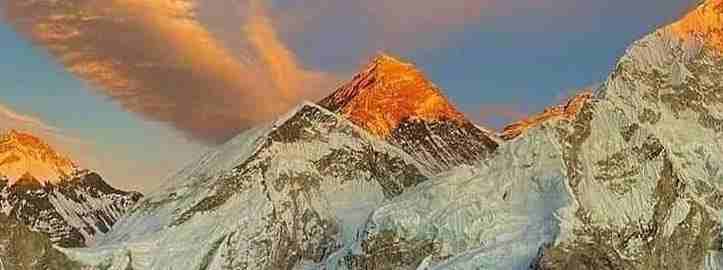
Everest Base Camp Trek 12 days
Price on request
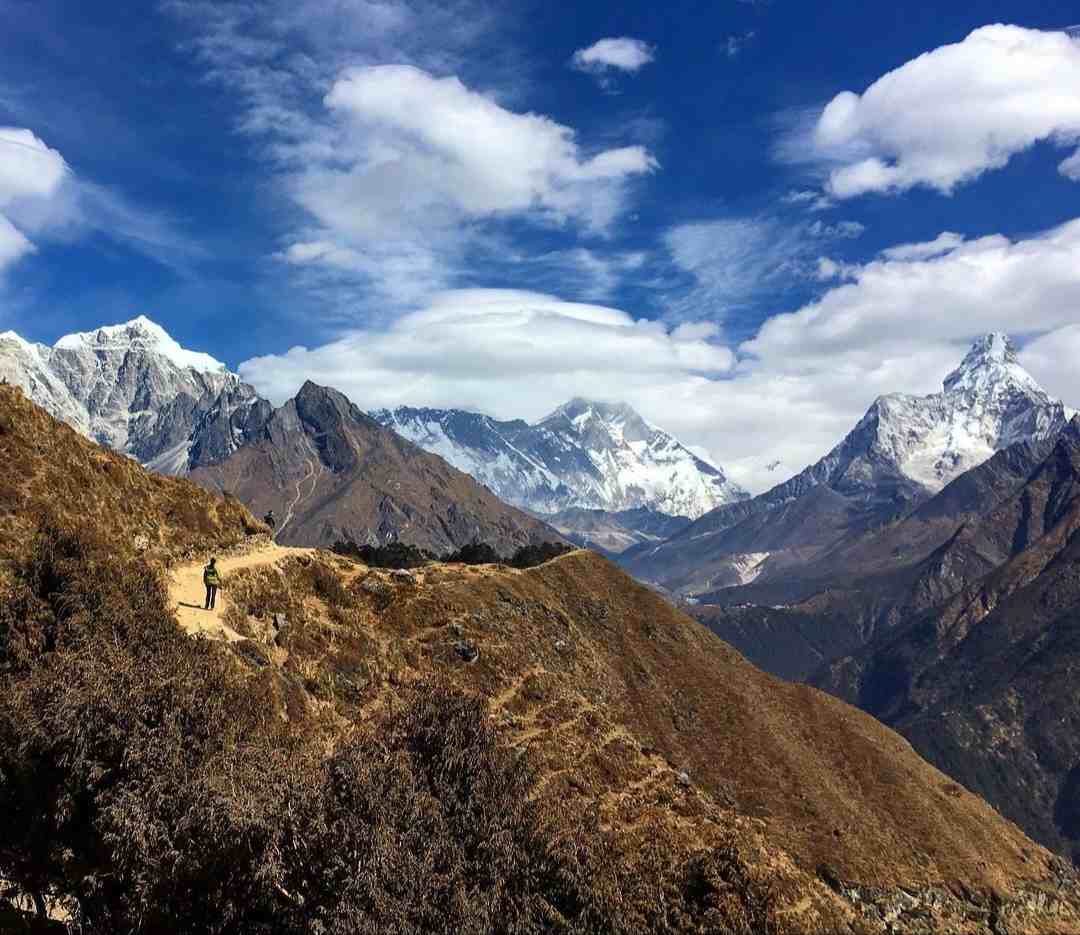
Everest View Trek
$ 1050.0 $ 790.0
The time duration of the expedition
Mt. Everest Expedition takes around 65 days to complete. It is much more difficult and treacherous than simply trekking to Everest Base Camp. Getting to the top of the highest mountain in the world is way more challenging and tougher than you think.
The weather and temperature, coupled with the climbing requirements for Everest, are demanding. As mentioned, plan for a long acc
Cost of Everest expedition
If you are going to attempt to climb Mt. Everest, costs are between $35,000 and $45,000. This range can increase based on your chosen facilities, but this cost is the minimum you will expect to pay. There are still some fixed costs that every climber has to pay. Many factors contribute to this price.
Permit costs
A Nepal Climbing Royalty for a foreign climber to heights above 8,000m costs $11,000 in high season, but costs half that in other seasons. Additionally, there are other permits that are part of the fee paid for this expedition.
Climbing gear
Everest climbing is challenging and technical. Climbers need proper climbing gear for a successful expedition. It is preferable for you to bring your own climbing gear, however Bold Himalaya can outfit you with climbing gear, for an additional cost.
Guides and Porter
Bold Himalaya has special Sherpa guides for mountain climbing. Climbing with an experienced guide makes your journey much easier, and is imperative for an expedition as highly technical as Everest.
Training
Climbers should be in the top physical form prior to arriving in Nepal. The company provides pre-training for climbing upon arrival.
Likewise, there are many that have to be taken care of while climbing Everest. The two months of preparation and climbing is not a short period; there are many things that make up the journey within that time, making the $35,000 to $45,000 cost for the Everest Expedition a reasonable price.
Climbing permits
Permits for restricted and mountain regions are required in Nepal. There are various permits needed for the Everest Expedition.
Khumbu Pasang Lhamu Rural Municipality Entrance Permit
This is the first permit required to enter the Everest region. The local government of Khumbu directly collects NPR 2000 per person from each foreigner. For your information, this is a new permit imposed from 1st of October 2018, replacing an existing TIMS Card. You can obtain this permit from both Lukla and Monjo.
Sagarmatha National Park Entry Permit
Sagarmatha National Park Entry permit is an existing permit system for entering National Park. You can obtain this permit either in Kathmandu at the Nepal Tourism Board Office or in Monjo at the Park Entrance Gate; the preferred way to obtain the permit. It will cost NPR 3000 per person.
NMA permit
Including Mt. Everest, there are other 26 mountain peaks of Nepal for which the Government of Nepal has authorized NMA to issue climbing permits. An NMA permit with an authorized signature is essential for the Everest Expedition.
Royalties of Mountain Climbing permits
Mountaineers/Climbers are required to pay Royalty to the Nepalese Government when climbing Mt. Everest. It costs $11,000 for spring, $5,500 for autumn, and $2,750 for winter seasons.
Along with permits, there are several other documents required for the Everest Expedition.
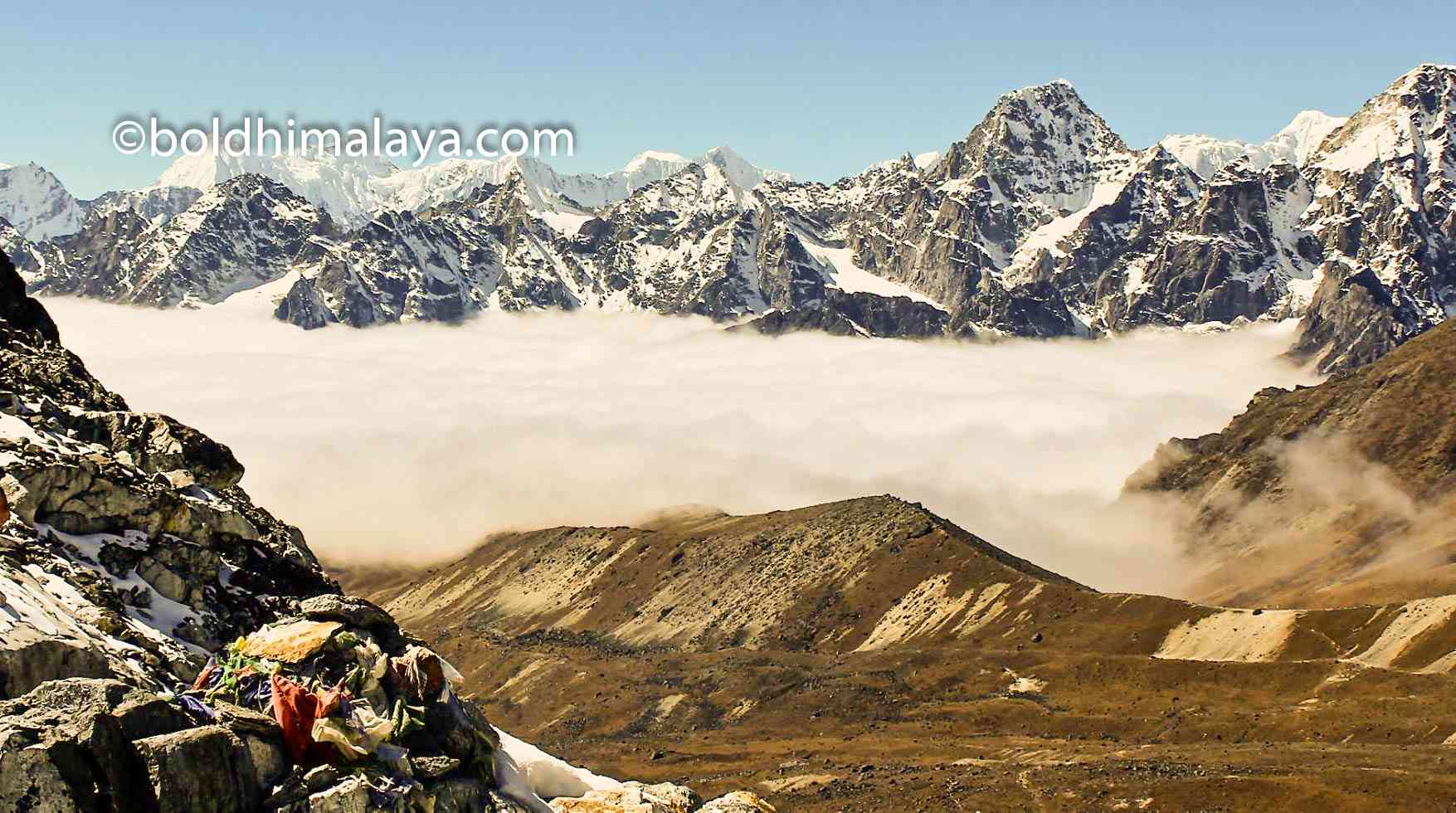 popular
popular
Everest Base Camp Trek with Gokyo Cho La Pass
$ 1950.0 $ 1500.0
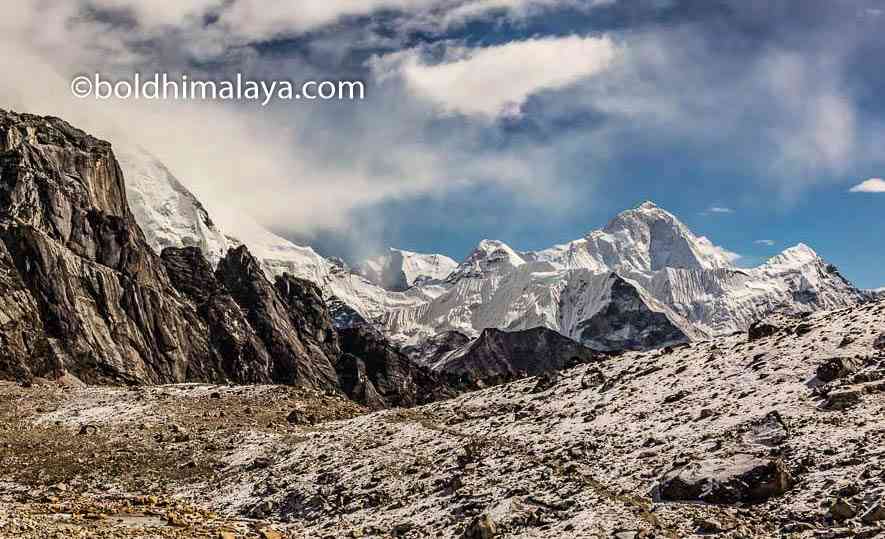
Everest Three Pass Trek
$ 2000.0 $ 1600.0
Highlights of Everest Expedition
The summit of the tallest mountain in the world is a goal that many climbers dream of reaching Surrounded by Himalayan mountains, Everest offers stunning views of all the great mountains of the world
The Mt.The Everest expedition also includes a trek to Tengboche Monastery; the oldest and highest monastery in Nepal
Everest expedition gives you time to explore Sherpa culture and lifestyle, along with other cultures and traditions found in Nepal
The highest National Park in the world is Sagarmatha National Park, famous for its pristine vegetation and wildlife, which is also included in the Everest expedition Alluring Khumbu Glacier and Khumbu Icefall are also part of the expedition
Only on the Everest expedition is the astounding view of the whole Everest region Magnificent views include those of Lhotse, Cho Oyu, Makalu, Amadablam, and various other mountains and peaks